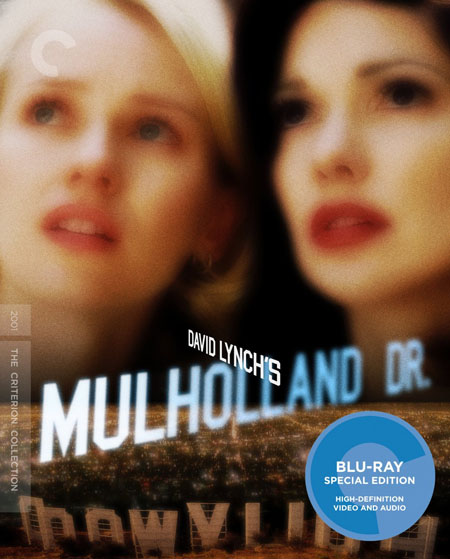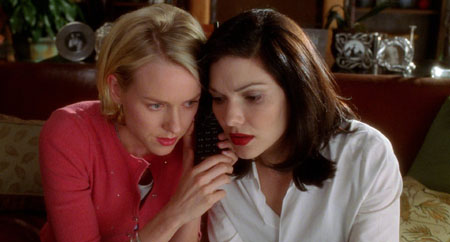
“WHAT DREAMS ARE
MADE OFâ€
By Raymond Benson
Of
all the talented filmmakers who have made a mark in the history of cinema,
there is that handful who belong in a
special category. Granted, many directors are auteurs, in that they have a recognizable style and thematic
consistency to their work—a “signature†that identifies them as the “authorsâ€
of their pictures. But there is a rare sub-set of auteurs who are so strikingly original and iconoclastic that their
work is singularly their own and unlike that of any other filmmaker. David
Lynch is one of these. No one makes the kind of movies he does.
Mulholland Drive is easily one of
Lynch’s best pictures (and he’s not very prolific, either—only ten feature
films to date, not counting television productions). It was released in 2001 to
massive critical acclaim (Lynch shared Best Director at Cannes with Joel Coen,
and he was nominated for a Best Director Oscar), as well as a great deal of
bafflement and mutterings from exiting audiences such as, “Well, that was weird.â€
Yes,
it’s a strange film—after all, it’s a David Lynch picture, and he is, perhaps,
the foremost proponent of surrealism in cinema since the advent of Luis Buñuel.
But Lynch is also a romanticist, and his blending of these two somewhat
conflicting artistic movements result in a distinctly different kind of animal,
something that has been coined “Lynchian.†There is a beauty to Mulholland Drive that is mesmerizing.
The mystery and ambiguity of its narrative is almost secondary to the emotional
punch the director delivers to the audience.
Much
has been written about the movie in an attempt to analyze it and make sense of
the non-linear plot, and it is, like all great art, open to interpretation. It
takes more than one viewing to “get†it, although I don’t think anyone can fully get it. If this is your first
encounter with Mulholland Drive—and
the new Criterion Collection Blu-ray edition is an excellent medium with which to approach the film—it is highly
suggested you watch the film in its entirety, and then view it again the
following day after thinking about it.

Basically,
the film is the sad, tragic story of a severely depressed and failed Hollywood
actress named Diane (played by Naomi Watts, in a brilliant, breakout
performance that shot her to “A†list status) who has been jilted by her
lesbian lover, Camilla (Laura Elena Harring) for a film director (Justin Theroux).
Diane hires a hit man to murder Camilla, and then kills herself out of remorse
and guilt. Doesn’t sound too savory, does it? Never mind—Lynch tells this story
in the form of a compelling quasi-neo-noir mystery, and in the process he creates
a puzzle for the audience to solve in order to connect the dots. Out of the
146-minutes of running time, nearly the first two hours of it consist of a
dream Diane is having which casts her as a wholesome, talented, optimistic and
aspiring actress named Betty. She meets an amnesiac victim who adopts the name
Rita (also Harring), and they set about attempting to find out how Rita came to
be in her situation. At around the 1:57:00 mark in the picture, Diane wakes
from her dream to her reality. What follows then are several non-linear flashbacks
to events that happened prior to Diane having her dream.
Dream
logic is usually nonsensical when analyzed upon waking, but during the actual
dream, everything makes sense, right? When watching the first two hours, you’ll
see several characters and objects that appear in relation to the “plot†of the
dream... but later, in the wakeful reality, the actors who played the earlier characters
and the same objects appear in different contexts—with a little thought you can
decipher how the dream connects these elements with the real circumstances. The
clues are all there on screen.
Another
interesting aspect of Mulholland Drive is
that it was originally a pilot for a possible television series a la Twin Peaks. Lynch had filmed the “dreamâ€
section of the picture, but the network rejected it. The director got financing
elsewhere, re-tooled the existing footage, wrote the rest of the story, and
brought the principles back for more shooting. This is why the detectives,
played by Robert Forster and Brent Briscoe, simply disappear from the movie
after the first half hour—they were originally intended to be regular
characters in the TV series. One can’t help but wonder what if.
This
fascinating film comes with a gorgeous new, restored 4K digital transfer,
supervised by Lynch and director of photography Peter Deming, with a 5.1
surround DTS-HD Master Audio soundtrack on the Blu-ray. Like most DVDs and
Blu-rays that Lynch approves, there are no chapter stops. Supplements include
some terrific new interviews with Lynch and Naomi Watts together (very funny
and revealing); Theroux, Harring, and Deming; composer Angelo Badalamenti (wait
until you hear how he got started writing film scores!); production designer
Jack Fisk; and casting director Johanna Ray. There’s a deleted scene, the
trailer, and a wonderful treat—on-set footage of Lynch directing several scenes
from the film. The booklet contains a 2005 interview with Lynch from Chris
Rodley’s book, Lynch on Lynch.
Mulholland Drive is a masterpiece in
David Lynch’s canon and the new Criterion release certainly does it justice. This
is a film that is haunting, beautiful, and full of secrets and surprises. It
really is the stuff that dreams are made of.
CLICK HERE TO ORDER FROM AMAZON